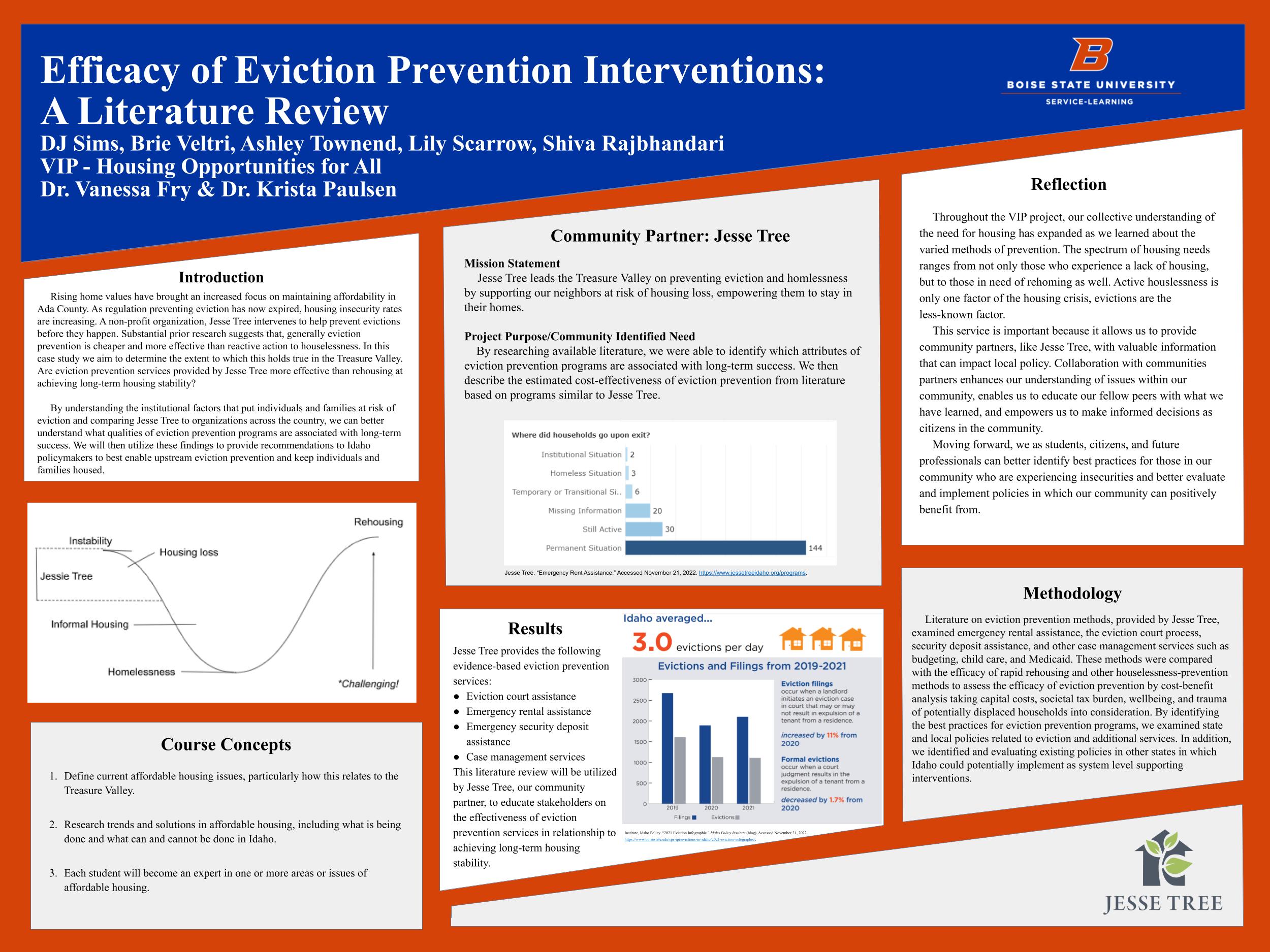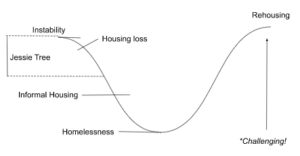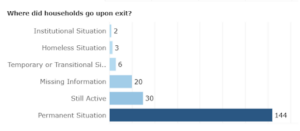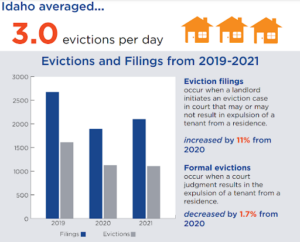DJ Sims, Brie Veltri, Ashley Townend, Lily Scarrow, Shiva Rajbhandari
Dr. Vanessa Fry & Dr. Krista Paulsen – VIP
Jesse Tree

Introduction
Rising home values have brought an increased focus on maintaining affordability in Ada County. As regulation preventing eviction has now expired, housing insecurity rates are increasing. A non-profit organization, Jesse Tree intervenes to help prevent evictions before they happen. Substantial prior research suggests that, generally eviction prevention is cheaper and more effective than reactive action to houselessness. In this case study we aim to determine the extent to which this holds true in the Treasure Valley. Are eviction prevention services provided by Jesse Tree more effective than rehousing at achieving long-term housing stability?
By understanding the institutional factors that put individuals and families at risk of eviction and comparing Jesse Tree to organizations across the country, we can better understand what qualities of eviction prevention programs are associated with long-term success. We will then utilize these findings to provide recommendations to Idaho policymakers to best enable upstream eviction prevention and keep individuals and families housed.

Community Partner: Jesse Tree
Mission Statement:
Jesse Tree leads the Treasure Valley on preventing eviction and homelessness by supporting our neighbors at risk of housing loss, empowering them to stay in their homes.
Project Purpose/Community Identified Need:
By researching available literature, we were able to identify which attributes of eviction prevention programs are associated with long-term success. We then describe the estimated cost-effectiveness of eviction prevention from literature based on programs similar to Jesse Tree.

Course Concepts
- Define current affordable housing issues, particularly how this relates to the Treasure Valley.
- Research trends and solutions in affordable housing, including what is being done and what can and cannot be done in Idaho.
- Each student will become an expert in one or more areas or issues of affordable housing.
Methodology
Literature on eviction prevention methods, provided by Jesse Tree, examined emergency rental assistance, the eviction court process, security deposit assistance, and other case management services such as budgeting, child care, and Medicaid. These methods were compared with the efficacy of rapid rehousing and other houselessness-prevention methods to assess the efficacy of eviction prevention by cost-benefit analysis taking capital costs, societal tax burden, wellbeing, and trauma of potentially displaced households into consideration. By identifying the best practices for eviction prevention programs, we examined state and local policies related to eviction and additional services. In addition, we identified and evaluating existing policies in other states in which Idaho could potentially implement as system level supporting interventions.
Reflection
Throughout the VIP project, our collective understanding of the need for housing has expanded as we learned about the varied methods of prevention. The spectrum of housing needs ranges from not only those who experience a lack of housing, but to those in need of rehoming as well. Active houslessness is only one factor of the housing crisis, evictions are the less-known factor.
This service is important because it allows us to provide community partners, like Jesse Tree, with valuable information that can impact local policy. Collaboration with communities partners enhances our understanding of issues within our community, enables us to educate our fellow peers with what we have learned, and empowers us to make informed decisions as citizens in the community.
Moving forward, we as students, citizens, and future professionals can better identify best practices for those in our community who are experiencing insecurities and better evaluate and implement policies in which our community can positively benefit from.
Results
Jesse Tree provides the following evidence-based eviction prevention services:
- Eviction court assistance
- Emergency rental assistance
- Emergency security deposit assistance
- Case management services
This literature review will be utilized by Jesse Tree, our community partner, to educate stakeholders on the effectiveness of eviction prevention services in relationship to achieving long-term housing stability.
